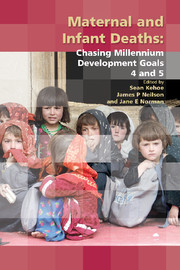Book contents
- Frontmatter
- Contents
- Participants
- Declaration of personal interests
- Preface
- The Millennium Development Goals
- SECTION 1 THE SIZE OF THE PROBLEM
- SECTION 2 CLINICAL PROBLEMS AND SOLUTIONS – MATERNAL
- 5 Postpartum haemorrhage
- 6 Reducing deaths from hypertensive disorders of pregnancy
- 7 Obstructed labour (including partograms)
- 8 Puerperal sepsis in low- and middle-income settings: past, present and future
- 9 Unsafe abortion and strategies to reduce its impact on women's lives
- 10 HIV and tuberculosis
- 11 A pragmatic approach to safe anaesthesia
- SECTION 3 CLINICAL PROBLEMS AND SOLUTIONS – NEONATAL
- SECTION 4 TRAINING AND DEVELOPMENT
- SECTION 5 SPECIFIC CHALLENGES IN SPECIFIC COUNTRIES
- SECTION 6 CONSENSUS VIEWS
- Index
5 - Postpartum haemorrhage
from SECTION 2 - CLINICAL PROBLEMS AND SOLUTIONS – MATERNAL
Published online by Cambridge University Press: 05 February 2014
- Frontmatter
- Contents
- Participants
- Declaration of personal interests
- Preface
- The Millennium Development Goals
- SECTION 1 THE SIZE OF THE PROBLEM
- SECTION 2 CLINICAL PROBLEMS AND SOLUTIONS – MATERNAL
- 5 Postpartum haemorrhage
- 6 Reducing deaths from hypertensive disorders of pregnancy
- 7 Obstructed labour (including partograms)
- 8 Puerperal sepsis in low- and middle-income settings: past, present and future
- 9 Unsafe abortion and strategies to reduce its impact on women's lives
- 10 HIV and tuberculosis
- 11 A pragmatic approach to safe anaesthesia
- SECTION 3 CLINICAL PROBLEMS AND SOLUTIONS – NEONATAL
- SECTION 4 TRAINING AND DEVELOPMENT
- SECTION 5 SPECIFIC CHALLENGES IN SPECIFIC COUNTRIES
- SECTION 6 CONSENSUS VIEWS
- Index
Summary
Introduction
Postpartum haemorrhage (PPH) is the most common cause of maternal deaths worldwide, responsible for 30% of all maternal deaths. This is equivalent to 150000 deaths annually or a death every 4 minutes. The danger of PPH comes not only from its rapid onset post delivery but also from the speed with which it causes maternal death. To prevent and treat PPH, therefore, a skilled birth attendant capable of managing PPH needs to be available at the birth. In the UK, despite universal access to heath care, around five women per year still die from PPH. The scale of the medical care needed to prevent death from PPH in the UK is reflected in the fact that 315 women undergo peripartum hysterectomy annually for massive haemorrhage, half of whom have an atonic uterus.
PPH is traditionally defined as the loss of over 500 ml blood in the first 24 hours after delivery. In reality, however, blood loss appears to be frequently higher than this in settings without prophylaxis. Measured median blood loss varies from 200 to 496 ml and the percentage of women with losses of over 500 ml varies from 12% to 51%. In clinical practice, therefore, birth attendants often use their clinical judgement to assess ‘abnormal loss’. In 2009, the RCOG amended its definition of PPH so that 500 ml is used as a point of ‘alert’ while treatment is only given once the women has lost 1000 ml.
- Type
- Chapter
- Information
- Maternal and Infant DeathsChasing Millennium Development Goals 4 and 5, pp. 85 - 98Publisher: Cambridge University PressPrint publication year: 2010
- 3
- Cited by



